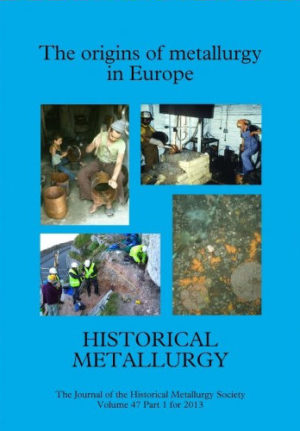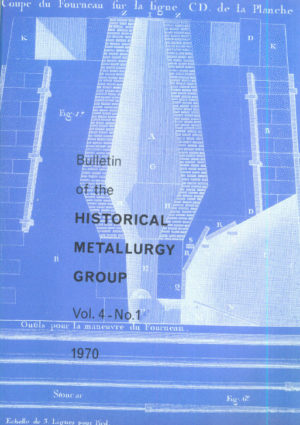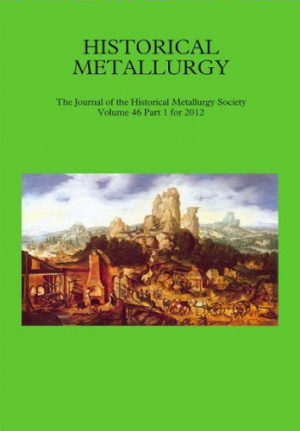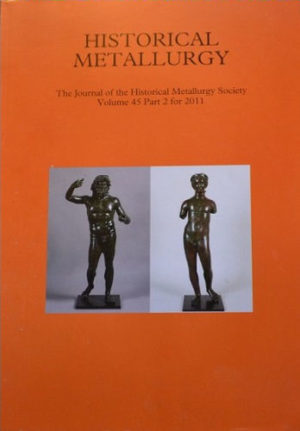Journal Contents
An assessment of lead smelting processes and the use of XRF for the analysis of resulting slags
Miciiael C Gill
Pages 63-78
This paper examines, by means of a bibiographic search and experimentation, the development of the techniques employed in lead smelting, during ancient and historical periods. Using the Phillips E D A X 9500, at the University of Bradford, School of Archaeological Sciences, a series of 24 quantative analyses was made, and the results used in a discussion of likely modes of slag formation. These problems associated with the production of reference standard, for use with XRF , are identified, and solutions proposed.
Some aspects of the origin of the blast furnace
Erik Tholander and Stig Blomgren
Pages 79-86
Alternative suggestions of provenance about the origin of the blast furnace have been Germany and Sweden and bids for its date of birth vary from the 12th to the 16th century. Some confusion certainly is due to the presence in the same period of the high bloomery (Germ. Stiickofen), also being a tall furnace capable of smelting coarse rock ore. Contemporary descriptions and characteristic criteria are lacking. Attempts based on various indications in archive material have not confirmed a very early appearance of the blast furnace. Other ways must be chosen to obtain objective grounds for the final judgement.
Recently, some interesting Swedish attempts have been made to use archaeological excavations of ancient furnace remains and microstructural examination of slag and iron as well as calculations based on chemical slag-analyses to establish the type of furnace being employed on three specific sites. Contradictory opinions are expressed in all of those cases, namly Harhyttan, Vinarhyttan andLapphyttan.
One way to tackle this problem objectively is to define clear criteria as to the necessary requirements and design features for the two types of furnace.
Primitive furnaces and the development of metallurgy
J E Rehder
Pages 87-92
The traditional view of the development of metallurgy is that only limited temperatures were attainable in early charcoal furnaces, and that smelting ability progressed from lead to iron as furnace temperature capability improved. It is demonstrated here by present-day combustion technology and by reference to published test work that a simple charcoal furnace 30 cm in diameter with a single tuyere easily powered by one man can reach 1,600 C in temperature and smelt iron ore to molten cast iron. The production of bloomery iron actually requires a decrease in furnace temperature. The application of the combustion of charcoal to various furnaces and the quantitative analysis of a shaft furnace are reviewed and it is pointed out that early development of metallurgy must have been much more conditioned by the availability of ore deposits than by furnace capability.
Metallography of brass in a 16th century astrolabe
Robert B Gordon
Pages 93-96
Metallographic examination of the brass in an astrolabe made in Nuremberg in 1537 shows it to be an alloy of copper and 19% zinc containing about 2% of iron, lead, and sulphur impurities. The outer ring of the astrolabe is a casting but the other parts were cut from hammered sheet that was fully annealed before use. The brass is of remarkably good quality except for surface defects in the sheet. The lead and sulphur impurities are present as inclusions visible in the microstructure. The lead particles are small and are uniformly dispersed. The sulphur is present in complex copper-zinc sulphides found in clusters or bands in the microstructure. These inclusions were probably formed during the cementation process by which the brass was made.
Interpretation of some Romano-British smithing slag from Awre in Gloucestershire
J R L Allen
Pages 97-104
Iron-making and/or iron-working residues occur at many archaeological sites of the Roman period in Britain. These residues tend to be described only cursorily, however, and to be reported essentially at the interpretative level. The recent development of slag typologies’ has led to many improvements in description and interpretation, but these schemes are insufficiently detailed and related to an understanding of process to be easily applied at every or even many sites. The need remains for detailed description, particularly of morphology, and for a better understanding of primitive iron-making and iron-working processes.
Using a process-related typology, this paper briefly describes a range of microscopic smithing residues recovered from a Romano-British iron-making site at Awre, Gloucestershire. In addition to the geological implications of the find, the voluminous and well preserved metallurgical materials from here seem to offer novel insights into the character and significance of smithing residues, particularly when their detailed examination is linked to the results of simple experiments with a slag-like material.
The origin of the copper used for the Statue of Liberty
J P Franey, T E Graedel, D L Nasii, K a y Lande Selmer and P R White
Pages 105-109
Historical records make no mention of the source of the copper used in the construction of the Statue of liberty, although a local tradition suggests that the copper came from the French-owned Visnes Mine near Bergen, Norway. Records show that ore from this mine, refined in France and Belgium, was a significant source of European copper in the late nineteenth century. To investigate further the origin of the statue copper, we have analyzed samples of copper from the Visnes Mine and from the Statue of liberty by emission spectrography. A comparison of the presence and concentrations of metallic impurities show the two samples to be very similar, and a review of historical and geographical information on possible suppliers of the copper suggests that the Visnes mine is a very likely source. We conclude that it is highly probable that copper from the Visnes Mine was used for the Statue of Liberty.
Comments on the oldest known lead figurine
Wladimir W Krysko
Pages 109-
What has become known over the years as the oldest known representation of the human form in lead is an object of some curiosity. The figurine is often referred to as having been found at Abydos in Upper Egypt.
![[Test] The Historical Metallurgy Society](https://test.historicalmetallurgy.org/wp-content/uploads/2020/02/Logo120.png)





There are no reviews yet.